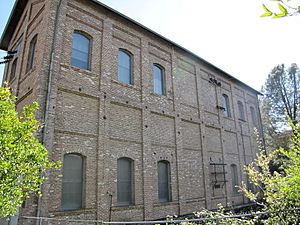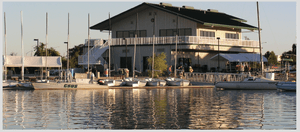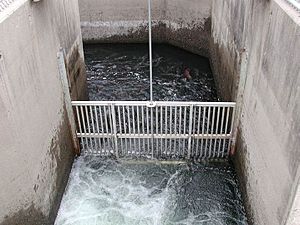Lake Natoma facts for kids
Quick facts for kids Lake Natoma |
|
|---|---|

View from southwest in 2014
|
|
| Lua error in Module:Location_map at line 416: Malformed coordinates value. | |
| Location | Sacramento County, California |
| Coordinates | ACoordinates: Longitude could not be parsed as a number: region:US-CA_type:waterbody Invalid arguments have been passed to the {{#coordinates:}} function |
| Type | Reservoir |
| Primary inflows | American River |
| Primary outflows | American River |
| Catchment area | 1,898 sq mi (4,920 km2) |
| Basin countries | United States |
| Average depth | 46 ft (14 m) |
| Water volume | 8,760 acre-feet (10,810 dam3) |
| Shore length1 | ~10 mi (16 km) |
| Surface elevation | 128 ft (39 m) |
| Settlements | Folsom, California |
| 1 Shore length is not a well-defined measure. | |
Lake Natoma is a beautiful small lake in the western United States. You can find it in Sacramento County, California. It sits along the lower American River, between the Folsom and Nimbus Dams.
This lake is part of the Folsom Lake State Recreation Area. This area helps take care of the lake's facilities and bike trails. Lake Natoma is about 15 miles east of Sacramento. It covers 500 acres of water and is about 4 miles long.
Lake Natoma is a popular spot for fun activities. People love to go rowing, kayaking, and swimming here. Powerboats are allowed, but they must go slowly, at 5 mph (8 km/h) or less. The lake is home to the Sacramento State Aquatic Center. It often hosts big rowing competitions, like the West Coast College Rowing Championships. The Lake Natoma Four Bridges Half Marathon also takes place here every October.
The lake area includes the historic Negro Bar in Folsom. This was an important gold rush mining camp for African-Americans. The Folsom Powerhouse State Historic Park also overlooks Lake Natoma. It's a California State Historical site that protects an old power station.
You can find a paved trail for cycling and jogging all around the lake. There are also dirt trails for horseback riding. The Folsom South Canal Trail starts at the lake too. You'll find several parking lots and boat ramps around the lake.
Contents
Discovering Lake Natoma's Past
Lake Natoma is a reservoir, which is a man-made lake. It was created in the 1950s. This happened after the Folsom Dam was built as part of the Central Valley Project. The Nimbus Dam was then constructed, which formed Lake Natoma.
The main purpose of Lake Natoma was to help manage the water released from Folsom Dam. It also provides water for irrigation canals. Plus, it helps generate hydroelectric power, which is electricity made from water. The Bureau of Reclamation operates both Lake Natoma and Folsom Lake.
Gold Mining History
Before Lake Natoma was created, the American River area it now covers was a busy place. Many gold mining operations took place here in the 1800s. People came looking for gold during the California Gold Rush.
Around 1956, the Bureau of Reclamation and California Department of Parks and Recreation made an agreement. State Parks became responsible for all the fun activities at Lake Natoma and Folsom Lake.
Fun and Recreation Over Time
In 1979, a plan for the Folsom Lake State Recreational Area was approved. This plan included Lake Natoma. As part of this plan, the Folsom Powerhouse State Historic Park became its own separate park.
By 2002, more people were visiting the area. So, meetings were held to plan for more recreational activities. This was to make sure there were enough fun things to do for everyone.
Folsom Powerhouse State Historic Park
On the south side of Lake Natoma, you'll find the old Folsom Powerhouse State Historic Park. It's in the city of Folsom. This powerhouse was very important. It was the first one to send electricity to Sacramento in 1895.
The powerhouse worked until 1952. That's when the new Folsom Dam was finished. The new dam made the old powerhouse unnecessary. This historic site once sent 11,000 volts of electricity over 22 miles to Sacramento. It is now listed on the National Register of Historic Places. You can visit the center to learn more about its history.
Exploring Lake Natoma's Landscape
This narrow lake is surrounded by hills, flat areas called plateaus, cliffs, and river canyons. A thick, 14-mile-long natural area called a riparian ecosystem circles the lake. The Lake Natoma Bluffs are 300 feet high. They line the lake from the Negro Bar to the Mississippi Bar.
Enjoying Recreational Activities
Many people visit Lake Natoma for fun, especially in the summer. You can easily get there using US Highway 50. Since the lake is close to a city, the State Recreational Area tries to protect the wildlife. They want to make sure both "recreation and nature" can exist together. In 2000, over 1.5 million people visited the Folsom Lake State Recreation Area, which includes Lake Natoma.
Water and Land Adventures
Lake Natoma first opened to the public in 1958. Popular water activities include kayaking, rowing, canoeing, swimming, water skiing, sailing, and fishing. On land, you can go hiking, biking, picnicking, jogging, and horseback riding.
You can also learn about the area's history. This includes information about the California Gold Rush and Native American life. You can also learn about the fish that live in the American River.
Major Facilities for Fun
Boat Launch Areas
The lake has three places to launch boats. These are for powerboats, jetskis, and sailboats. Two launches have hard surfaces, and one is gravel. There's plenty of room to turn around and park. Fishermen often use the Negro Bar launch. Many fishing tournaments happen nearby. California State University Sacramento (CSUS) also holds rowing classes here.
Campgrounds for Overnight Stays
There is one campground open to the public at Lake Natoma. It's called Negro Bar Group Campground.
Willow Creek Area
The Willow Creek inlet to Lake Natoma is a great spot for both land and water fun. People come here for picnicking, birdwatching, fishing, and canoeing. The Lake Natoma Trail is also very close by.
Aquatic Center for CSUS
Right where the Nimbus Dam ends, you'll find an Aquatic Center. It belongs to California State University Sacramento (CSUS). This is where CSUS holds some of their water sports classes, like skiing and wind surfing.
Bike Paths
A bike path runs along the East Trail and West Trail of Nimbus Dam. This path follows the edge of Lake Natoma.
Dirt Trails for Exploring
There are six miles of dirt trails leading to Nimbus Flat and Willow Creek. You can also find dirt trails on both sides of Lake Natoma. One is six miles long, and the other is nine miles.
Nimbus Fish Hatchery
Below Nimbus Dam and Lake Natoma is the Nimbus Fish Hatchery. The California Department of Fish and Games runs it. It was built in 1955. The hatchery has a visitor center where you can learn about fish. It helps fish like salmon and steelheads reproduce. It has a special "fish ladder" to guide them. The hatchery produces millions of Chinook salmon and hundreds of thousands of Steelhead trout each year. These fish help keep the rivers and lakes in Northern and Central California stocked for fishing.
Animals Living in and Around Lake Natoma
Many native animals call this area home. You might see mule deer, coyotes, bobcats, and even mountain lions. Birds like quail, bald eagles, golden eagles, herons, and egrets live here. You might also spot western pond turtles and California horned lizards.
Common fish in Lake Natoma include catfish and carp. Other fish found here are bass, bluegill, and green sunfish. These aquatic animals can usually handle warm water and low oxygen levels. Right under Nimbus Dam, you might find steelheads, Chinook salmon, American shad, and Pacific lampreys.
Bald eagles and golden eagles nest around Folsom Lake and Lake Natoma. About six bald eagles and two golden eagles are seen every year. Both types of eagles are protected by the Federal Bald Eagle Protection Act of 1940.
Environmental Concerns: Mercury in Fish
Some fish in Lake Natoma have been found to have higher levels of mercury in their bodies. Mercury levels in some fish have reached or gone above guidelines set by the U.S. Environmental Protection Agency.
Mercury can build up in fish over time, especially in larger, older fish. This is called bioaccumulation. Fish that are predators, like large bass or white catfish, often have higher mercury levels.
Because of this, the California Office of Environmental Health Hazard Assessment (OEHHA) has created a safe eating advisory for fish caught in Lake Natoma. This advisory helps people know how much fish is safe to eat.




